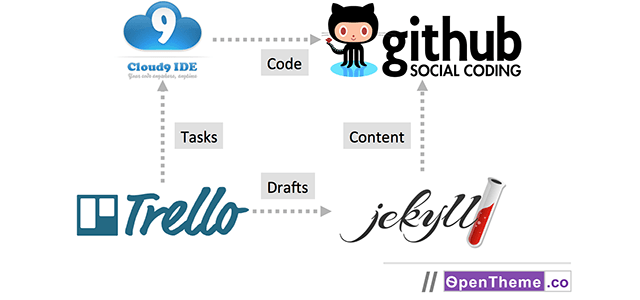Open Cloud Based Workflow For Designing Your Website
Design your next website with the freedom of switching from any device, to any place, to any operating system. All you need is a web browser.
Nov 26, 2014 • Manav Sehgal • ~ 2 min to read • github jekyll

Design your next website with the freedom of switching from any device, to any place, to any operating system. All you need is a web browser.
I have Windows enviornment at work, Mac at my home office, and use Android phone and iPad when mobile. I author articles, ebooks, and create code.
My requirement is to seamlessly move from one device to next, from one place to next, without losing any time getting to next authoring or coding activity.
I have discovered a loosely coupled workflow tying four useful tools together, which lets me enjoy this any device/OS/place freedom.
- Cloud9. This is where I do my coding and writing. Cloud9 offers a cloud based Integrated Development Environment.
- GitHub. What ties it all together. Saving my work on GitHub means, even when I need to setup a new development or authoring environment, I always have my latest code or content handy.
- Jekyll. Static website content management for GitHub. I use this to enable a simple, yet powerful content workflow.
- Trello. Very useful when extending my activities to a community of collaborators or peers at work. Used for planning, collaborating, brain-storming, and communicating.
Cloud9 As Your Dev, Authoring Box
You can actually skip this step altogether. If you desire a simpler workflow and don’t plan to test Jekyll builds before publishing to GitHub, you can simply fork/clone OpenTheme as your own GitHub project and edit, create posts directly within GitHub.
If you plan to do your custom build of Semantic UI, or modify the OpenTheme to your requirements, then you may want to consider Cloud9 over setting up a dev box on your local machine.
Cloud9 comes with three big advantages over a local dev box setup.
Pre-configured dev environment. Basic Cloud9 box has several Jekyll dependencies already pre-installed. Including Ruby. All you need to do is check versions and update the required gems in case you want to be on the latest.
Cloud-to-cloud is faster. Cloning, committing from-to GitHub is from Cloud9 servers to GitHub servers. Latency is minimal, even if you are running on a GPS connection.
Mobility. Combination of the first two benefits means I can switch connection speeds, networks, machines, OS, screen sizes and yet start from the last line I wrote or coded within no time.